Auditing Theory and Practice: Evaluating Audit Procedures and Controls
VerifiedAdded on 2020/04/07
|15
|3632
|48
Report
AI Summary
This report provides a detailed analysis of auditing theory and practice, addressing key aspects such as ethical considerations, risk assessment, and internal controls. The report begins by examining ethical issues, including conflicts of interest and the auditor's responsibility to protect public interest. It then delves into the concept of business risk and how it can lead to material misstatements in financial statements, providing specific examples and relevant ISA 315 guidelines. The report also explores various audit procedures, including the evaluation of control deficiencies and the testing of controls using computer-assisted audit techniques (CAATs). Furthermore, it discusses specific threats to auditor independence, such as self-review, advocacy, familiarity, and self-interest threats, along with appropriate safeguards. The report also covers deficiencies in internal controls, such as the lack of integration between a website and inventory systems, and provides recommendations for improvements. Overall, the report offers a comprehensive overview of auditing principles and practices, making it a valuable resource for students studying auditing.
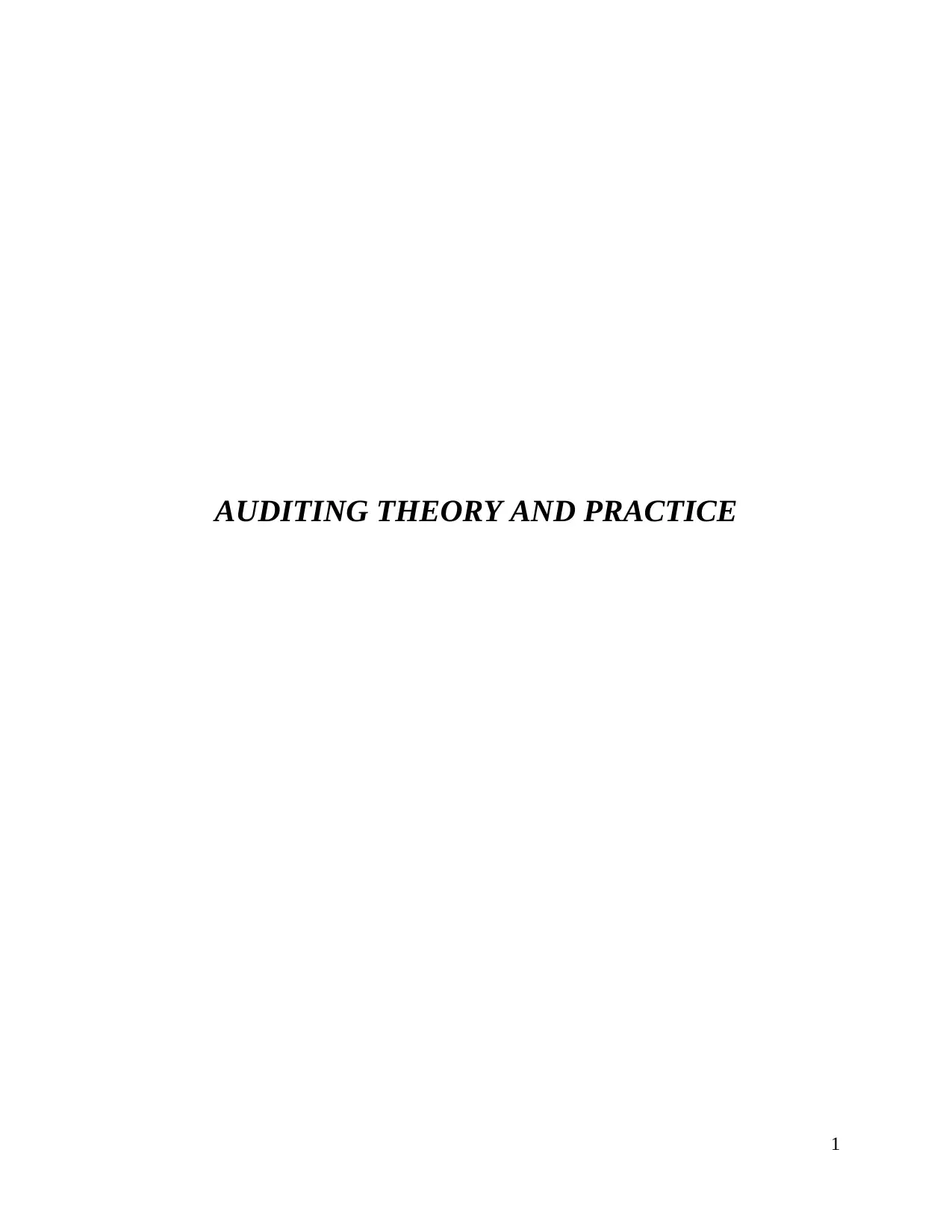
AUDITING THEORY AND PRACTICE
1
1
Paraphrase This Document
Need a fresh take? Get an instant paraphrase of this document with our AI Paraphraser
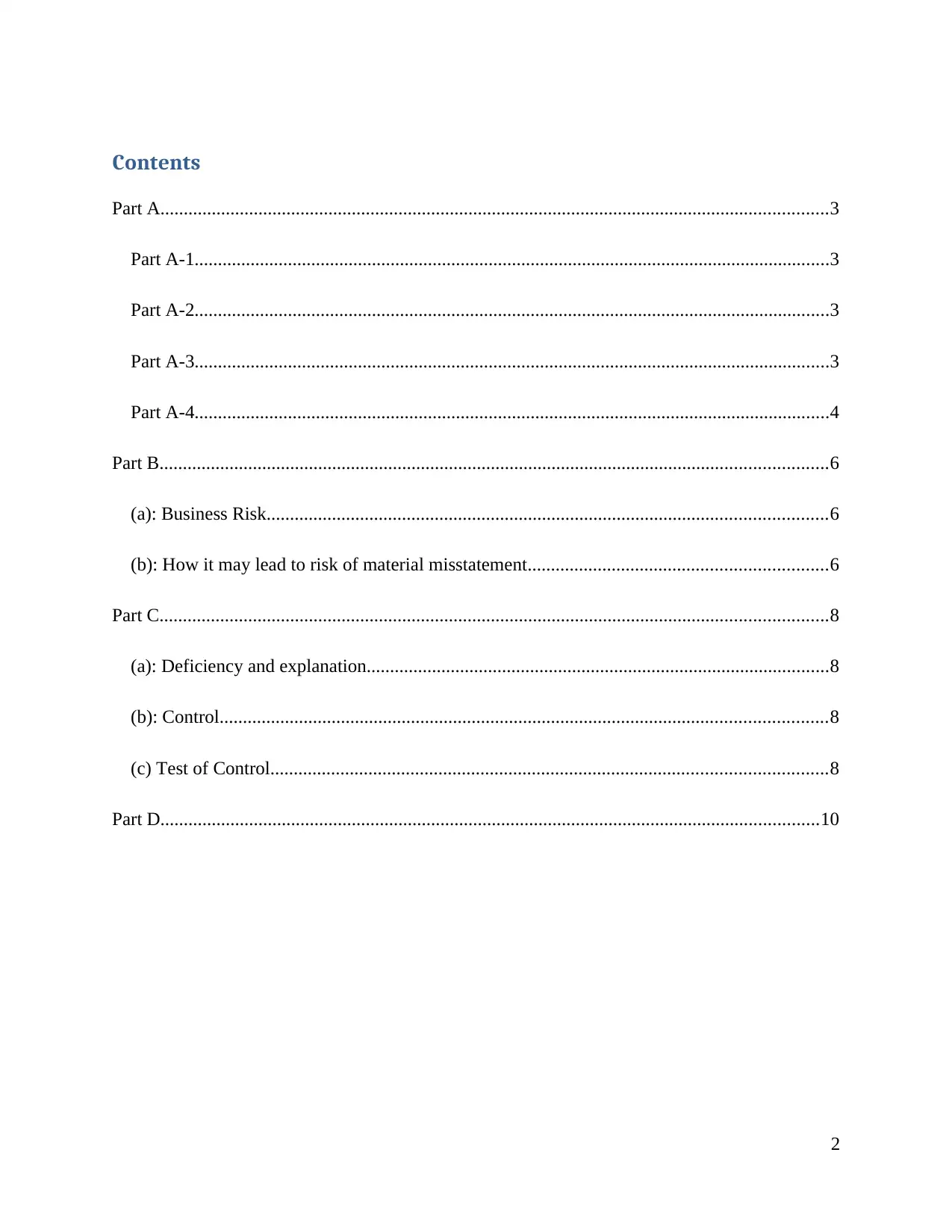
Contents
Part A...............................................................................................................................................3
Part A-1........................................................................................................................................3
Part A-2........................................................................................................................................3
Part A-3........................................................................................................................................3
Part A-4........................................................................................................................................4
Part B...............................................................................................................................................6
(a): Business Risk........................................................................................................................6
(b): How it may lead to risk of material misstatement................................................................6
Part C...............................................................................................................................................8
(a): Deficiency and explanation...................................................................................................8
(b): Control..................................................................................................................................8
(c) Test of Control.......................................................................................................................8
Part D.............................................................................................................................................10
2
Part A...............................................................................................................................................3
Part A-1........................................................................................................................................3
Part A-2........................................................................................................................................3
Part A-3........................................................................................................................................3
Part A-4........................................................................................................................................4
Part B...............................................................................................................................................6
(a): Business Risk........................................................................................................................6
(b): How it may lead to risk of material misstatement................................................................6
Part C...............................................................................................................................................8
(a): Deficiency and explanation...................................................................................................8
(b): Control..................................................................................................................................8
(c) Test of Control.......................................................................................................................8
Part D.............................................................................................................................................10
2
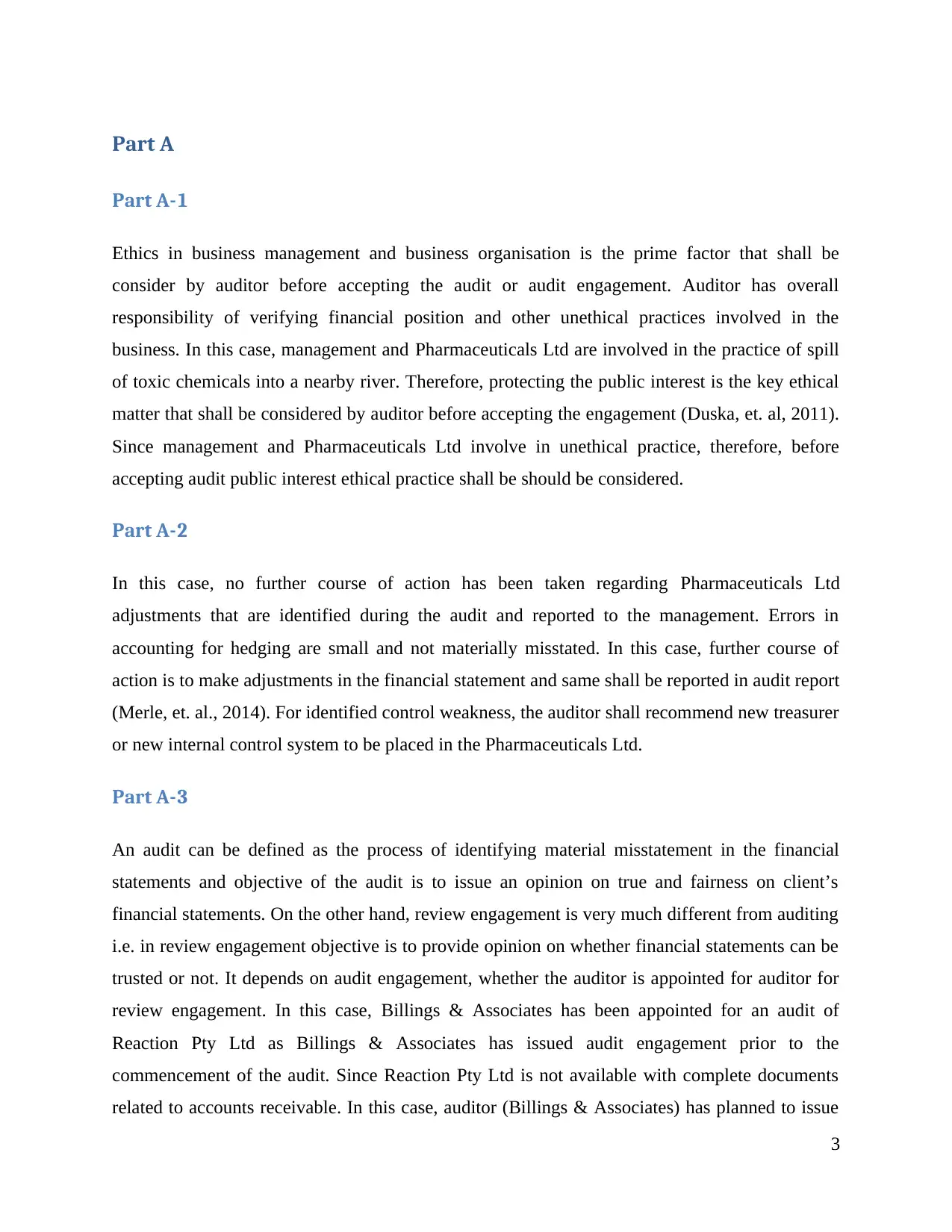
Part A
Part A-1
Ethics in business management and business organisation is the prime factor that shall be
consider by auditor before accepting the audit or audit engagement. Auditor has overall
responsibility of verifying financial position and other unethical practices involved in the
business. In this case, management and Pharmaceuticals Ltd are involved in the practice of spill
of toxic chemicals into a nearby river. Therefore, protecting the public interest is the key ethical
matter that shall be considered by auditor before accepting the engagement (Duska, et. al, 2011).
Since management and Pharmaceuticals Ltd involve in unethical practice, therefore, before
accepting audit public interest ethical practice shall be should be considered.
Part A-2
In this case, no further course of action has been taken regarding Pharmaceuticals Ltd
adjustments that are identified during the audit and reported to the management. Errors in
accounting for hedging are small and not materially misstated. In this case, further course of
action is to make adjustments in the financial statement and same shall be reported in audit report
(Merle, et. al., 2014). For identified control weakness, the auditor shall recommend new treasurer
or new internal control system to be placed in the Pharmaceuticals Ltd.
Part A-3
An audit can be defined as the process of identifying material misstatement in the financial
statements and objective of the audit is to issue an opinion on true and fairness on client’s
financial statements. On the other hand, review engagement is very much different from auditing
i.e. in review engagement objective is to provide opinion on whether financial statements can be
trusted or not. It depends on audit engagement, whether the auditor is appointed for auditor for
review engagement. In this case, Billings & Associates has been appointed for an audit of
Reaction Pty Ltd as Billings & Associates has issued audit engagement prior to the
commencement of the audit. Since Reaction Pty Ltd is not available with complete documents
related to accounts receivable. In this case, auditor (Billings & Associates) has planned to issue
3
Part A-1
Ethics in business management and business organisation is the prime factor that shall be
consider by auditor before accepting the audit or audit engagement. Auditor has overall
responsibility of verifying financial position and other unethical practices involved in the
business. In this case, management and Pharmaceuticals Ltd are involved in the practice of spill
of toxic chemicals into a nearby river. Therefore, protecting the public interest is the key ethical
matter that shall be considered by auditor before accepting the engagement (Duska, et. al, 2011).
Since management and Pharmaceuticals Ltd involve in unethical practice, therefore, before
accepting audit public interest ethical practice shall be should be considered.
Part A-2
In this case, no further course of action has been taken regarding Pharmaceuticals Ltd
adjustments that are identified during the audit and reported to the management. Errors in
accounting for hedging are small and not materially misstated. In this case, further course of
action is to make adjustments in the financial statement and same shall be reported in audit report
(Merle, et. al., 2014). For identified control weakness, the auditor shall recommend new treasurer
or new internal control system to be placed in the Pharmaceuticals Ltd.
Part A-3
An audit can be defined as the process of identifying material misstatement in the financial
statements and objective of the audit is to issue an opinion on true and fairness on client’s
financial statements. On the other hand, review engagement is very much different from auditing
i.e. in review engagement objective is to provide opinion on whether financial statements can be
trusted or not. It depends on audit engagement, whether the auditor is appointed for auditor for
review engagement. In this case, Billings & Associates has been appointed for an audit of
Reaction Pty Ltd as Billings & Associates has issued audit engagement prior to the
commencement of the audit. Since Reaction Pty Ltd is not available with complete documents
related to accounts receivable. In this case, auditor (Billings & Associates) has planned to issue
3
⊘ This is a preview!⊘
Do you want full access?
Subscribe today to unlock all pages.

Trusted by 1+ million students worldwide
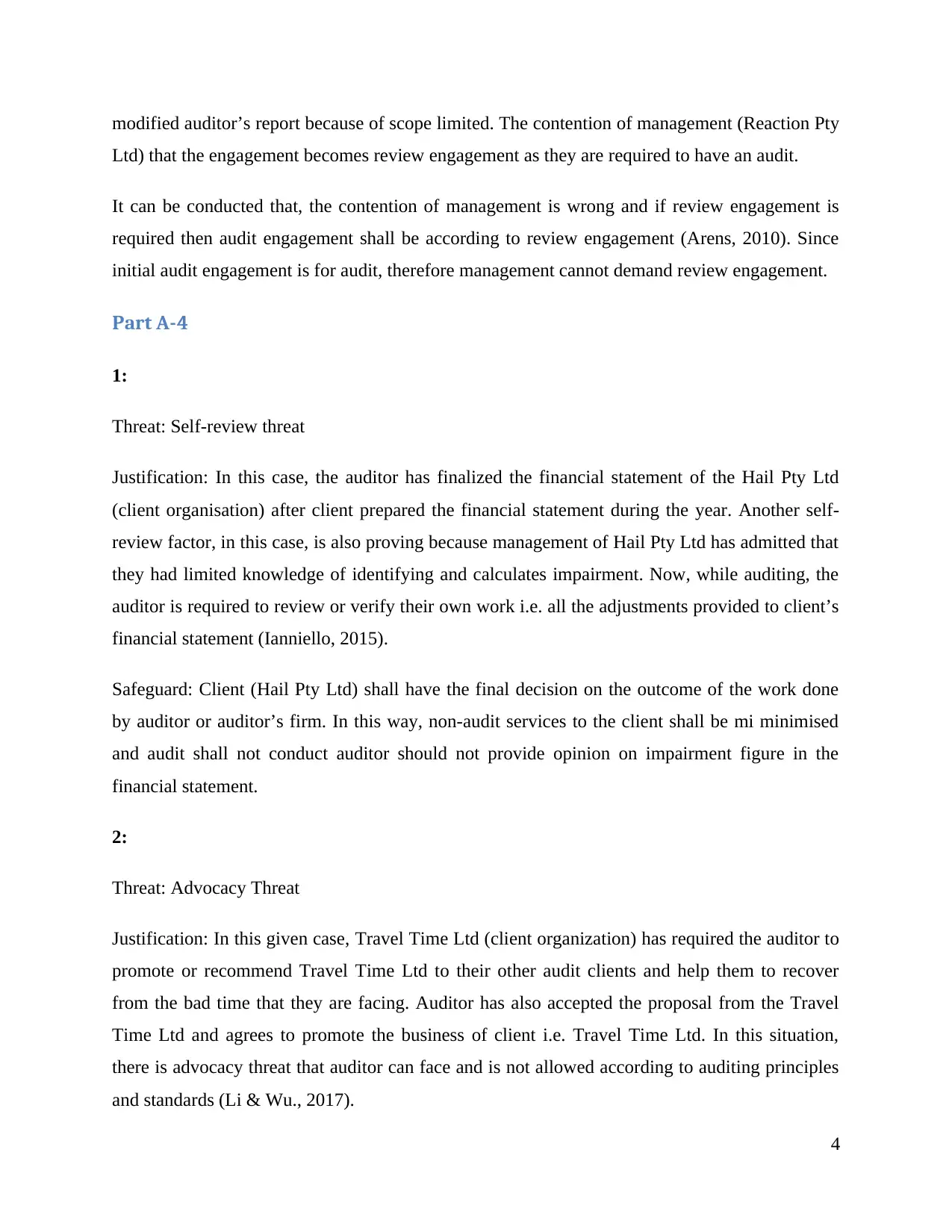
modified auditor’s report because of scope limited. The contention of management (Reaction Pty
Ltd) that the engagement becomes review engagement as they are required to have an audit.
It can be conducted that, the contention of management is wrong and if review engagement is
required then audit engagement shall be according to review engagement (Arens, 2010). Since
initial audit engagement is for audit, therefore management cannot demand review engagement.
Part A-4
1:
Threat: Self-review threat
Justification: In this case, the auditor has finalized the financial statement of the Hail Pty Ltd
(client organisation) after client prepared the financial statement during the year. Another self-
review factor, in this case, is also proving because management of Hail Pty Ltd has admitted that
they had limited knowledge of identifying and calculates impairment. Now, while auditing, the
auditor is required to review or verify their own work i.e. all the adjustments provided to client’s
financial statement (Ianniello, 2015).
Safeguard: Client (Hail Pty Ltd) shall have the final decision on the outcome of the work done
by auditor or auditor’s firm. In this way, non-audit services to the client shall be mi minimised
and audit shall not conduct auditor should not provide opinion on impairment figure in the
financial statement.
2:
Threat: Advocacy Threat
Justification: In this given case, Travel Time Ltd (client organization) has required the auditor to
promote or recommend Travel Time Ltd to their other audit clients and help them to recover
from the bad time that they are facing. Auditor has also accepted the proposal from the Travel
Time Ltd and agrees to promote the business of client i.e. Travel Time Ltd. In this situation,
there is advocacy threat that auditor can face and is not allowed according to auditing principles
and standards (Li & Wu., 2017).
4
Ltd) that the engagement becomes review engagement as they are required to have an audit.
It can be conducted that, the contention of management is wrong and if review engagement is
required then audit engagement shall be according to review engagement (Arens, 2010). Since
initial audit engagement is for audit, therefore management cannot demand review engagement.
Part A-4
1:
Threat: Self-review threat
Justification: In this case, the auditor has finalized the financial statement of the Hail Pty Ltd
(client organisation) after client prepared the financial statement during the year. Another self-
review factor, in this case, is also proving because management of Hail Pty Ltd has admitted that
they had limited knowledge of identifying and calculates impairment. Now, while auditing, the
auditor is required to review or verify their own work i.e. all the adjustments provided to client’s
financial statement (Ianniello, 2015).
Safeguard: Client (Hail Pty Ltd) shall have the final decision on the outcome of the work done
by auditor or auditor’s firm. In this way, non-audit services to the client shall be mi minimised
and audit shall not conduct auditor should not provide opinion on impairment figure in the
financial statement.
2:
Threat: Advocacy Threat
Justification: In this given case, Travel Time Ltd (client organization) has required the auditor to
promote or recommend Travel Time Ltd to their other audit clients and help them to recover
from the bad time that they are facing. Auditor has also accepted the proposal from the Travel
Time Ltd and agrees to promote the business of client i.e. Travel Time Ltd. In this situation,
there is advocacy threat that auditor can face and is not allowed according to auditing principles
and standards (Li & Wu., 2017).
4
Paraphrase This Document
Need a fresh take? Get an instant paraphrase of this document with our AI Paraphraser
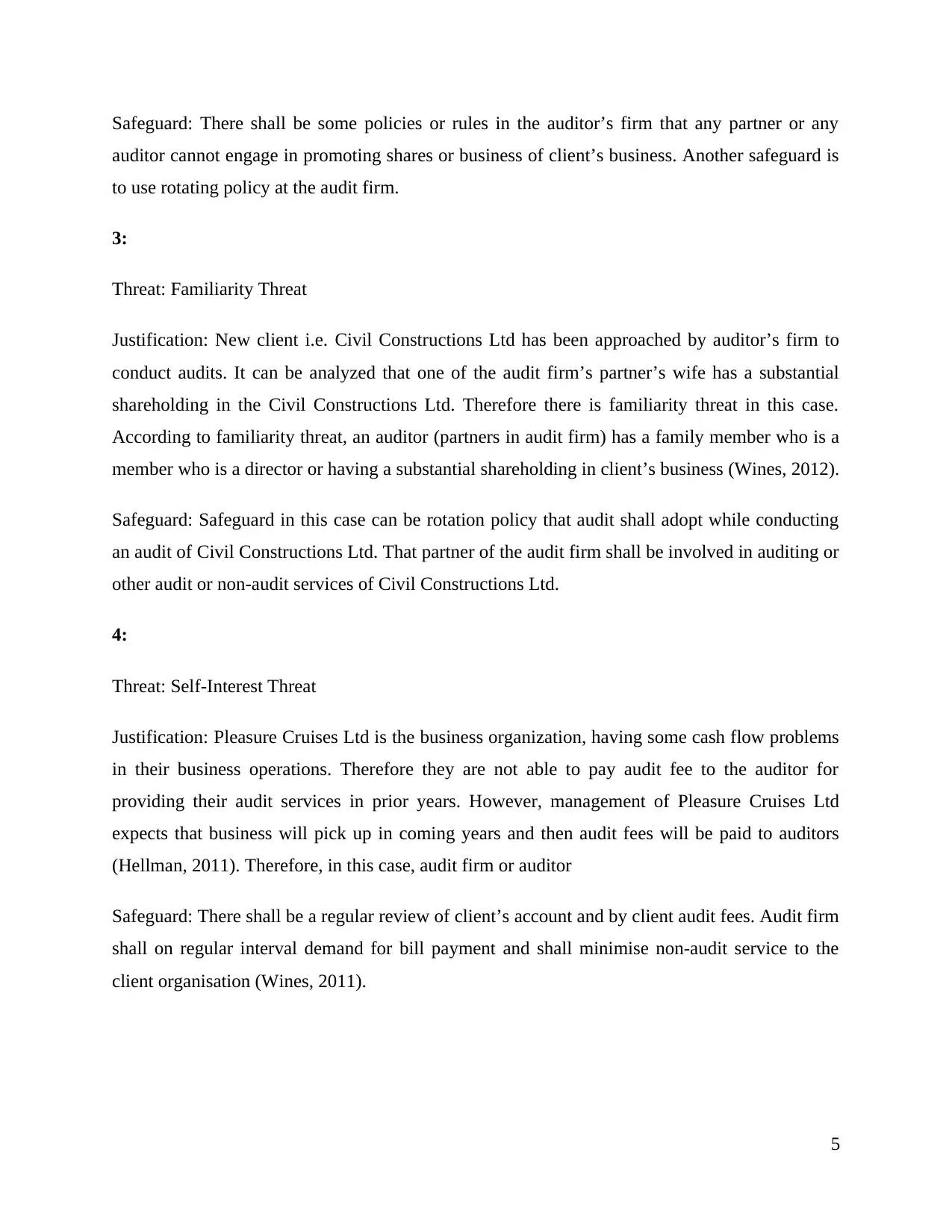
Safeguard: There shall be some policies or rules in the auditor’s firm that any partner or any
auditor cannot engage in promoting shares or business of client’s business. Another safeguard is
to use rotating policy at the audit firm.
3:
Threat: Familiarity Threat
Justification: New client i.e. Civil Constructions Ltd has been approached by auditor’s firm to
conduct audits. It can be analyzed that one of the audit firm’s partner’s wife has a substantial
shareholding in the Civil Constructions Ltd. Therefore there is familiarity threat in this case.
According to familiarity threat, an auditor (partners in audit firm) has a family member who is a
member who is a director or having a substantial shareholding in client’s business (Wines, 2012).
Safeguard: Safeguard in this case can be rotation policy that audit shall adopt while conducting
an audit of Civil Constructions Ltd. That partner of the audit firm shall be involved in auditing or
other audit or non-audit services of Civil Constructions Ltd.
4:
Threat: Self-Interest Threat
Justification: Pleasure Cruises Ltd is the business organization, having some cash flow problems
in their business operations. Therefore they are not able to pay audit fee to the auditor for
providing their audit services in prior years. However, management of Pleasure Cruises Ltd
expects that business will pick up in coming years and then audit fees will be paid to auditors
(Hellman, 2011). Therefore, in this case, audit firm or auditor
Safeguard: There shall be a regular review of client’s account and by client audit fees. Audit firm
shall on regular interval demand for bill payment and shall minimise non-audit service to the
client organisation (Wines, 2011).
5
auditor cannot engage in promoting shares or business of client’s business. Another safeguard is
to use rotating policy at the audit firm.
3:
Threat: Familiarity Threat
Justification: New client i.e. Civil Constructions Ltd has been approached by auditor’s firm to
conduct audits. It can be analyzed that one of the audit firm’s partner’s wife has a substantial
shareholding in the Civil Constructions Ltd. Therefore there is familiarity threat in this case.
According to familiarity threat, an auditor (partners in audit firm) has a family member who is a
member who is a director or having a substantial shareholding in client’s business (Wines, 2012).
Safeguard: Safeguard in this case can be rotation policy that audit shall adopt while conducting
an audit of Civil Constructions Ltd. That partner of the audit firm shall be involved in auditing or
other audit or non-audit services of Civil Constructions Ltd.
4:
Threat: Self-Interest Threat
Justification: Pleasure Cruises Ltd is the business organization, having some cash flow problems
in their business operations. Therefore they are not able to pay audit fee to the auditor for
providing their audit services in prior years. However, management of Pleasure Cruises Ltd
expects that business will pick up in coming years and then audit fees will be paid to auditors
(Hellman, 2011). Therefore, in this case, audit firm or auditor
Safeguard: There shall be a regular review of client’s account and by client audit fees. Audit firm
shall on regular interval demand for bill payment and shall minimise non-audit service to the
client organisation (Wines, 2011).
5
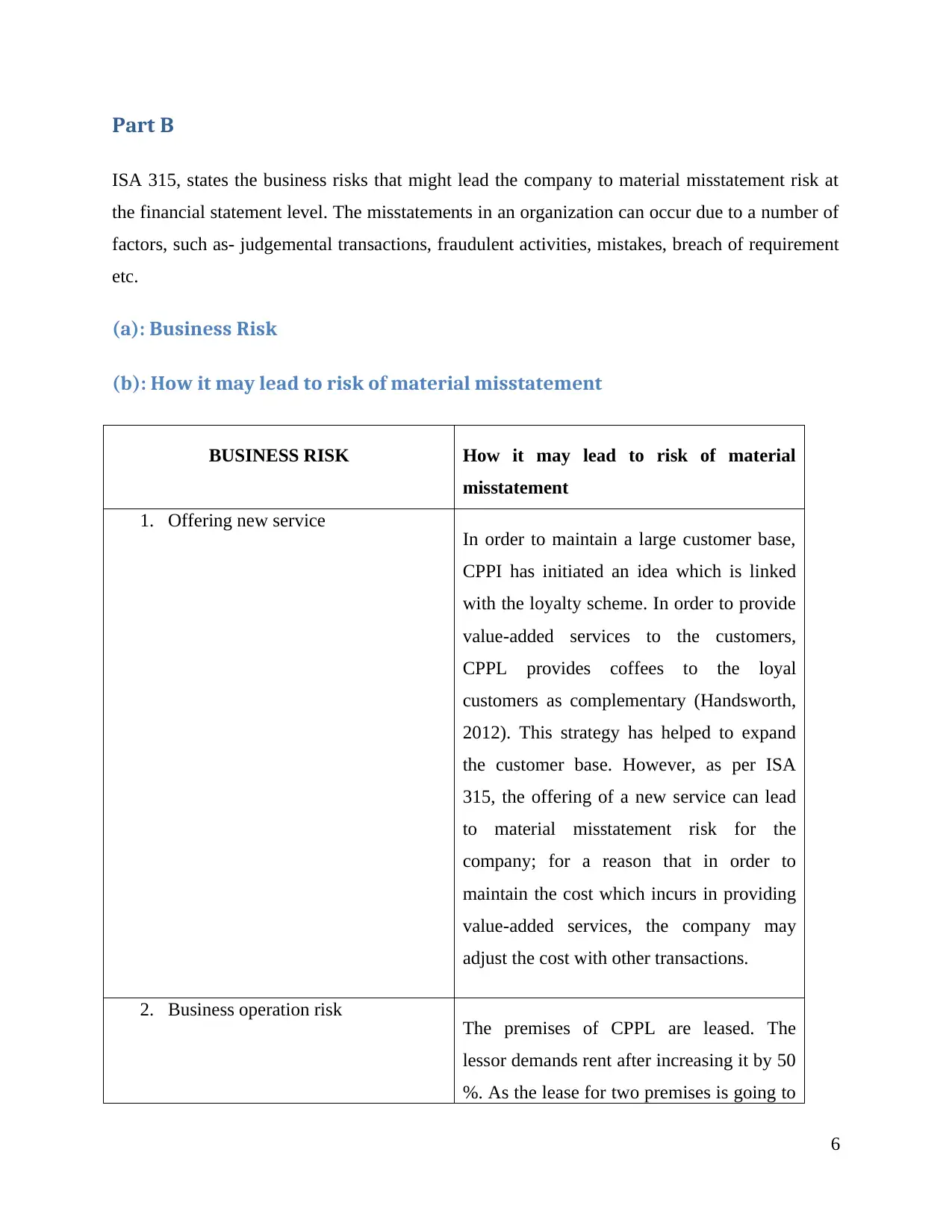
Part B
ISA 315, states the business risks that might lead the company to material misstatement risk at
the financial statement level. The misstatements in an organization can occur due to a number of
factors, such as- judgemental transactions, fraudulent activities, mistakes, breach of requirement
etc.
(a): Business Risk
(b): How it may lead to risk of material misstatement
BUSINESS RISK How it may lead to risk of material
misstatement
1. Offering new service In order to maintain a large customer base,
CPPI has initiated an idea which is linked
with the loyalty scheme. In order to provide
value-added services to the customers,
CPPL provides coffees to the loyal
customers as complementary (Handsworth,
2012). This strategy has helped to expand
the customer base. However, as per ISA
315, the offering of a new service can lead
to material misstatement risk for the
company; for a reason that in order to
maintain the cost which incurs in providing
value-added services, the company may
adjust the cost with other transactions.
2. Business operation risk The premises of CPPL are leased. The
lessor demands rent after increasing it by 50
%. As the lease for two premises is going to
6
ISA 315, states the business risks that might lead the company to material misstatement risk at
the financial statement level. The misstatements in an organization can occur due to a number of
factors, such as- judgemental transactions, fraudulent activities, mistakes, breach of requirement
etc.
(a): Business Risk
(b): How it may lead to risk of material misstatement
BUSINESS RISK How it may lead to risk of material
misstatement
1. Offering new service In order to maintain a large customer base,
CPPI has initiated an idea which is linked
with the loyalty scheme. In order to provide
value-added services to the customers,
CPPL provides coffees to the loyal
customers as complementary (Handsworth,
2012). This strategy has helped to expand
the customer base. However, as per ISA
315, the offering of a new service can lead
to material misstatement risk for the
company; for a reason that in order to
maintain the cost which incurs in providing
value-added services, the company may
adjust the cost with other transactions.
2. Business operation risk The premises of CPPL are leased. The
lessor demands rent after increasing it by 50
%. As the lease for two premises is going to
6
⊘ This is a preview!⊘
Do you want full access?
Subscribe today to unlock all pages.

Trusted by 1+ million students worldwide
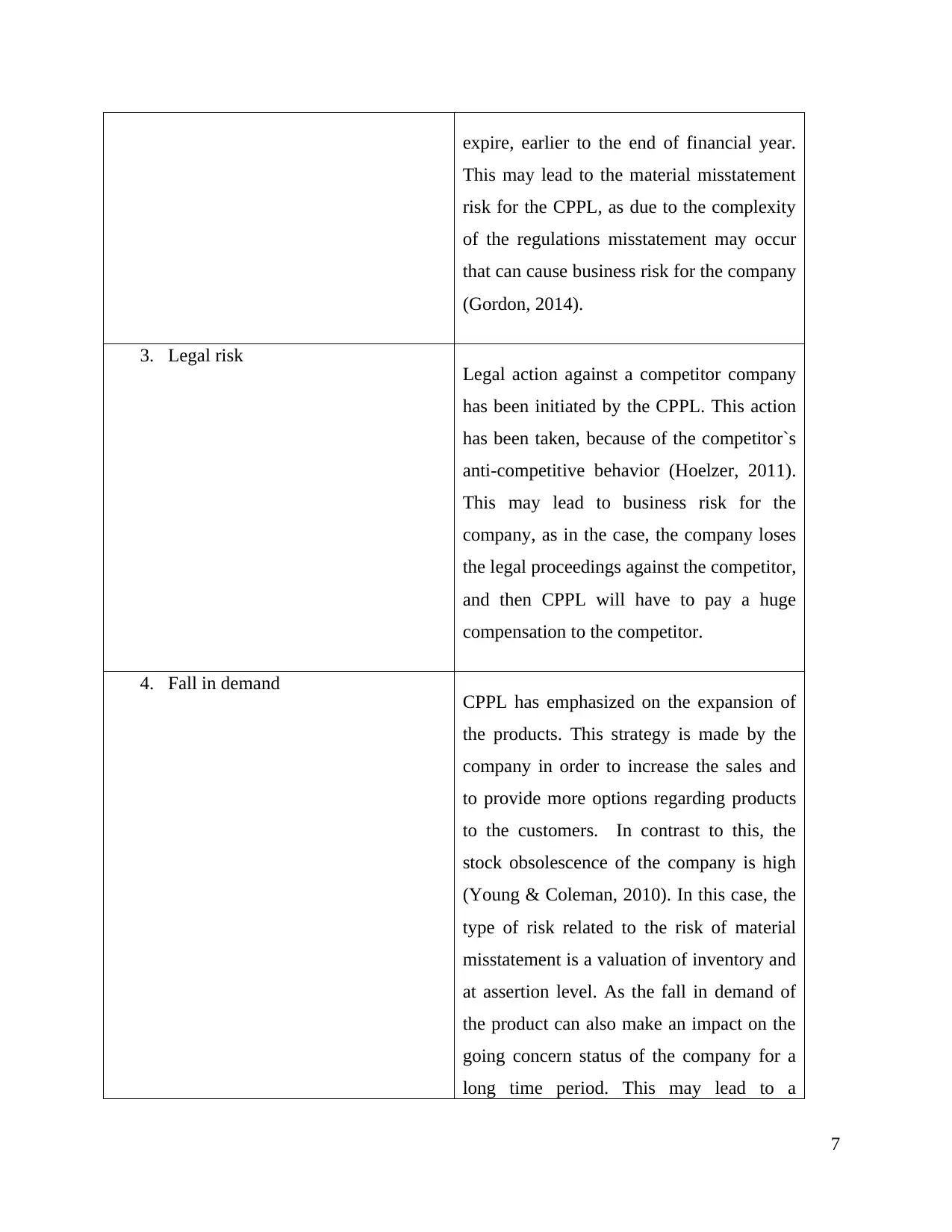
expire, earlier to the end of financial year.
This may lead to the material misstatement
risk for the CPPL, as due to the complexity
of the regulations misstatement may occur
that can cause business risk for the company
(Gordon, 2014).
3. Legal risk Legal action against a competitor company
has been initiated by the CPPL. This action
has been taken, because of the competitor`s
anti-competitive behavior (Hoelzer, 2011).
This may lead to business risk for the
company, as in the case, the company loses
the legal proceedings against the competitor,
and then CPPL will have to pay a huge
compensation to the competitor.
4. Fall in demand CPPL has emphasized on the expansion of
the products. This strategy is made by the
company in order to increase the sales and
to provide more options regarding products
to the customers. In contrast to this, the
stock obsolescence of the company is high
(Young & Coleman, 2010). In this case, the
type of risk related to the risk of material
misstatement is a valuation of inventory and
at assertion level. As the fall in demand of
the product can also make an impact on the
going concern status of the company for a
long time period. This may lead to a
7
This may lead to the material misstatement
risk for the CPPL, as due to the complexity
of the regulations misstatement may occur
that can cause business risk for the company
(Gordon, 2014).
3. Legal risk Legal action against a competitor company
has been initiated by the CPPL. This action
has been taken, because of the competitor`s
anti-competitive behavior (Hoelzer, 2011).
This may lead to business risk for the
company, as in the case, the company loses
the legal proceedings against the competitor,
and then CPPL will have to pay a huge
compensation to the competitor.
4. Fall in demand CPPL has emphasized on the expansion of
the products. This strategy is made by the
company in order to increase the sales and
to provide more options regarding products
to the customers. In contrast to this, the
stock obsolescence of the company is high
(Young & Coleman, 2010). In this case, the
type of risk related to the risk of material
misstatement is a valuation of inventory and
at assertion level. As the fall in demand of
the product can also make an impact on the
going concern status of the company for a
long time period. This may lead to a
7
Paraphrase This Document
Need a fresh take? Get an instant paraphrase of this document with our AI Paraphraser
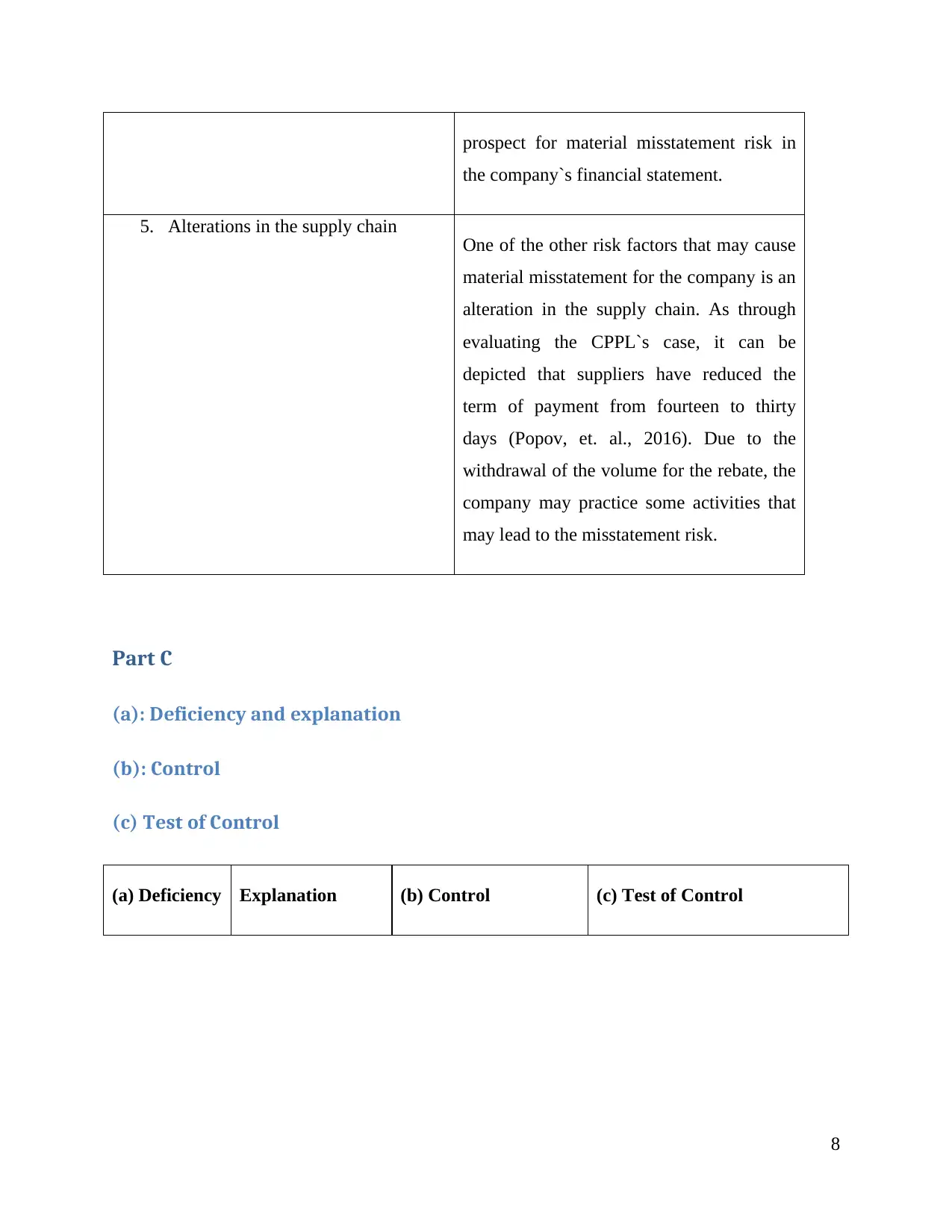
prospect for material misstatement risk in
the company`s financial statement.
5. Alterations in the supply chain One of the other risk factors that may cause
material misstatement for the company is an
alteration in the supply chain. As through
evaluating the CPPL`s case, it can be
depicted that suppliers have reduced the
term of payment from fourteen to thirty
days (Popov, et. al., 2016). Due to the
withdrawal of the volume for the rebate, the
company may practice some activities that
may lead to the misstatement risk.
Part C
(a): Deficiency and explanation
(b): Control
(c) Test of Control
(a) Deficiency Explanation (b) Control (c) Test of Control
8
the company`s financial statement.
5. Alterations in the supply chain One of the other risk factors that may cause
material misstatement for the company is an
alteration in the supply chain. As through
evaluating the CPPL`s case, it can be
depicted that suppliers have reduced the
term of payment from fourteen to thirty
days (Popov, et. al., 2016). Due to the
withdrawal of the volume for the rebate, the
company may practice some activities that
may lead to the misstatement risk.
Part C
(a): Deficiency and explanation
(b): Control
(c) Test of Control
(a) Deficiency Explanation (b) Control (c) Test of Control
8
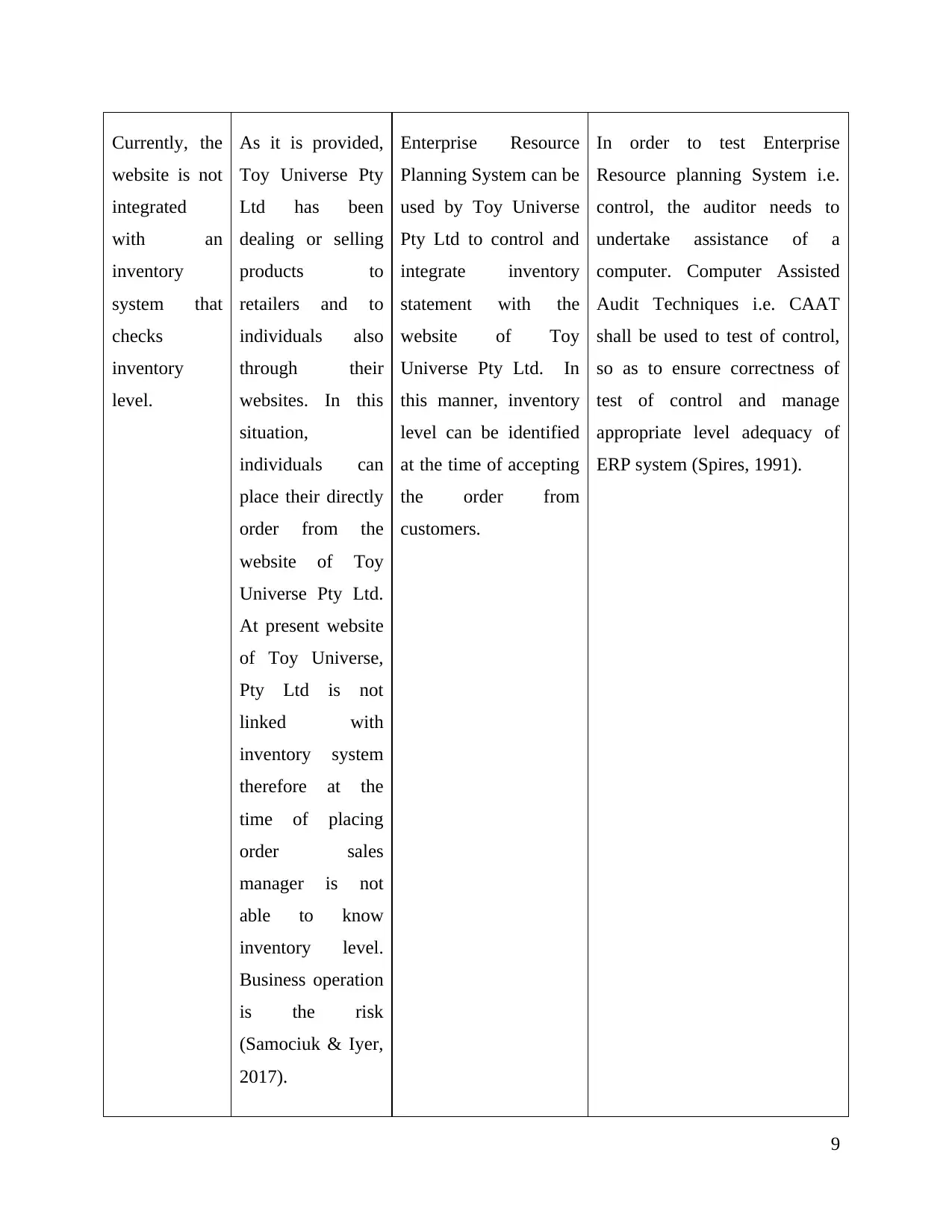
Currently, the
website is not
integrated
with an
inventory
system that
checks
inventory
level.
As it is provided,
Toy Universe Pty
Ltd has been
dealing or selling
products to
retailers and to
individuals also
through their
websites. In this
situation,
individuals can
place their directly
order from the
website of Toy
Universe Pty Ltd.
At present website
of Toy Universe,
Pty Ltd is not
linked with
inventory system
therefore at the
time of placing
order sales
manager is not
able to know
inventory level.
Business operation
is the risk
(Samociuk & Iyer,
2017).
Enterprise Resource
Planning System can be
used by Toy Universe
Pty Ltd to control and
integrate inventory
statement with the
website of Toy
Universe Pty Ltd. In
this manner, inventory
level can be identified
at the time of accepting
the order from
customers.
In order to test Enterprise
Resource planning System i.e.
control, the auditor needs to
undertake assistance of a
computer. Computer Assisted
Audit Techniques i.e. CAAT
shall be used to test of control,
so as to ensure correctness of
test of control and manage
appropriate level adequacy of
ERP system (Spires, 1991).
9
website is not
integrated
with an
inventory
system that
checks
inventory
level.
As it is provided,
Toy Universe Pty
Ltd has been
dealing or selling
products to
retailers and to
individuals also
through their
websites. In this
situation,
individuals can
place their directly
order from the
website of Toy
Universe Pty Ltd.
At present website
of Toy Universe,
Pty Ltd is not
linked with
inventory system
therefore at the
time of placing
order sales
manager is not
able to know
inventory level.
Business operation
is the risk
(Samociuk & Iyer,
2017).
Enterprise Resource
Planning System can be
used by Toy Universe
Pty Ltd to control and
integrate inventory
statement with the
website of Toy
Universe Pty Ltd. In
this manner, inventory
level can be identified
at the time of accepting
the order from
customers.
In order to test Enterprise
Resource planning System i.e.
control, the auditor needs to
undertake assistance of a
computer. Computer Assisted
Audit Techniques i.e. CAAT
shall be used to test of control,
so as to ensure correctness of
test of control and manage
appropriate level adequacy of
ERP system (Spires, 1991).
9
⊘ This is a preview!⊘
Do you want full access?
Subscribe today to unlock all pages.

Trusted by 1+ million students worldwide
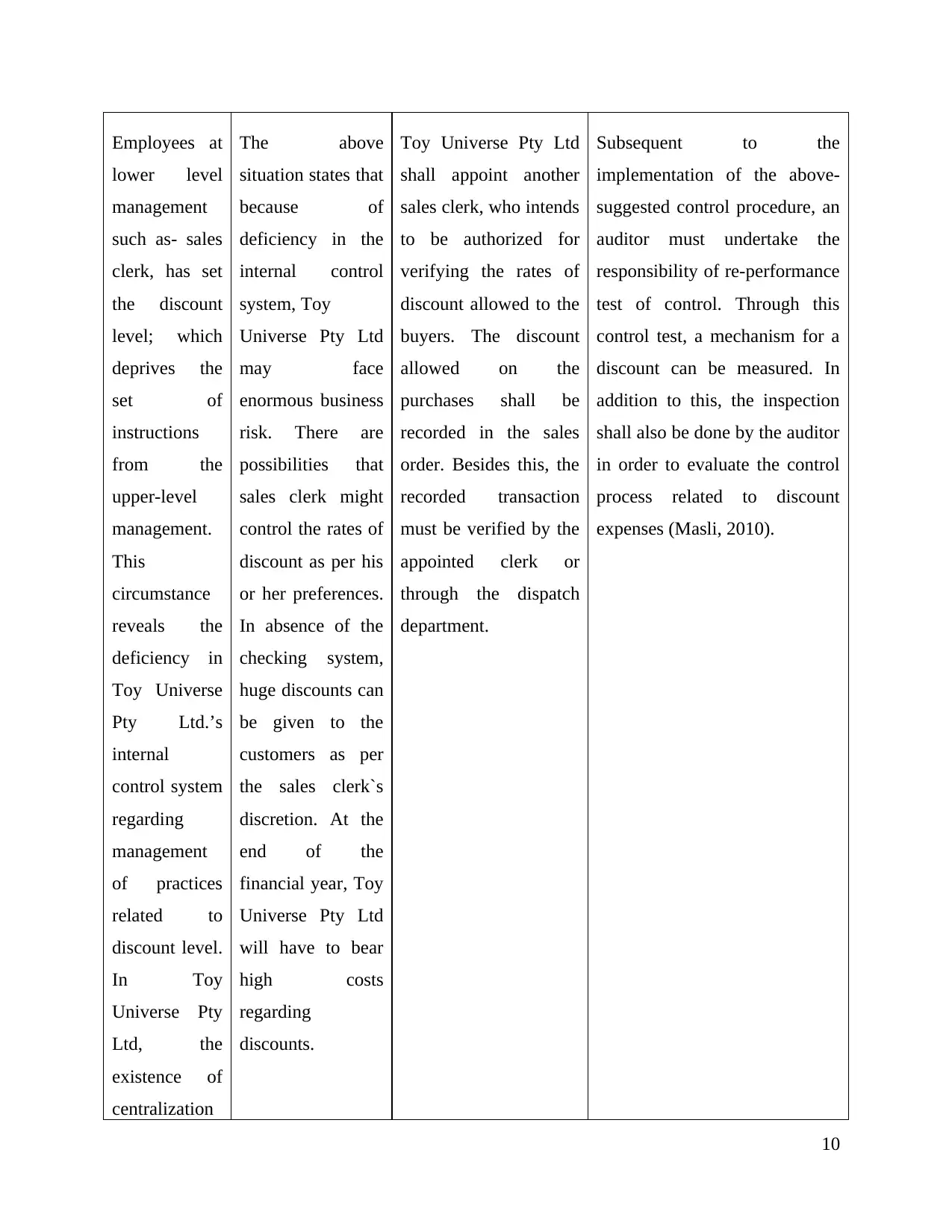
Employees at
lower level
management
such as- sales
clerk, has set
the discount
level; which
deprives the
set of
instructions
from the
upper-level
management.
This
circumstance
reveals the
deficiency in
Toy Universe
Pty Ltd.’s
internal
control system
regarding
management
of practices
related to
discount level.
In Toy
Universe Pty
Ltd, the
existence of
centralization
The above
situation states that
because of
deficiency in the
internal control
system, Toy
Universe Pty Ltd
may face
enormous business
risk. There are
possibilities that
sales clerk might
control the rates of
discount as per his
or her preferences.
In absence of the
checking system,
huge discounts can
be given to the
customers as per
the sales clerk`s
discretion. At the
end of the
financial year, Toy
Universe Pty Ltd
will have to bear
high costs
regarding
discounts.
Toy Universe Pty Ltd
shall appoint another
sales clerk, who intends
to be authorized for
verifying the rates of
discount allowed to the
buyers. The discount
allowed on the
purchases shall be
recorded in the sales
order. Besides this, the
recorded transaction
must be verified by the
appointed clerk or
through the dispatch
department.
Subsequent to the
implementation of the above-
suggested control procedure, an
auditor must undertake the
responsibility of re-performance
test of control. Through this
control test, a mechanism for a
discount can be measured. In
addition to this, the inspection
shall also be done by the auditor
in order to evaluate the control
process related to discount
expenses (Masli, 2010).
10
lower level
management
such as- sales
clerk, has set
the discount
level; which
deprives the
set of
instructions
from the
upper-level
management.
This
circumstance
reveals the
deficiency in
Toy Universe
Pty Ltd.’s
internal
control system
regarding
management
of practices
related to
discount level.
In Toy
Universe Pty
Ltd, the
existence of
centralization
The above
situation states that
because of
deficiency in the
internal control
system, Toy
Universe Pty Ltd
may face
enormous business
risk. There are
possibilities that
sales clerk might
control the rates of
discount as per his
or her preferences.
In absence of the
checking system,
huge discounts can
be given to the
customers as per
the sales clerk`s
discretion. At the
end of the
financial year, Toy
Universe Pty Ltd
will have to bear
high costs
regarding
discounts.
Toy Universe Pty Ltd
shall appoint another
sales clerk, who intends
to be authorized for
verifying the rates of
discount allowed to the
buyers. The discount
allowed on the
purchases shall be
recorded in the sales
order. Besides this, the
recorded transaction
must be verified by the
appointed clerk or
through the dispatch
department.
Subsequent to the
implementation of the above-
suggested control procedure, an
auditor must undertake the
responsibility of re-performance
test of control. Through this
control test, a mechanism for a
discount can be measured. In
addition to this, the inspection
shall also be done by the auditor
in order to evaluate the control
process related to discount
expenses (Masli, 2010).
10
Paraphrase This Document
Need a fresh take? Get an instant paraphrase of this document with our AI Paraphraser
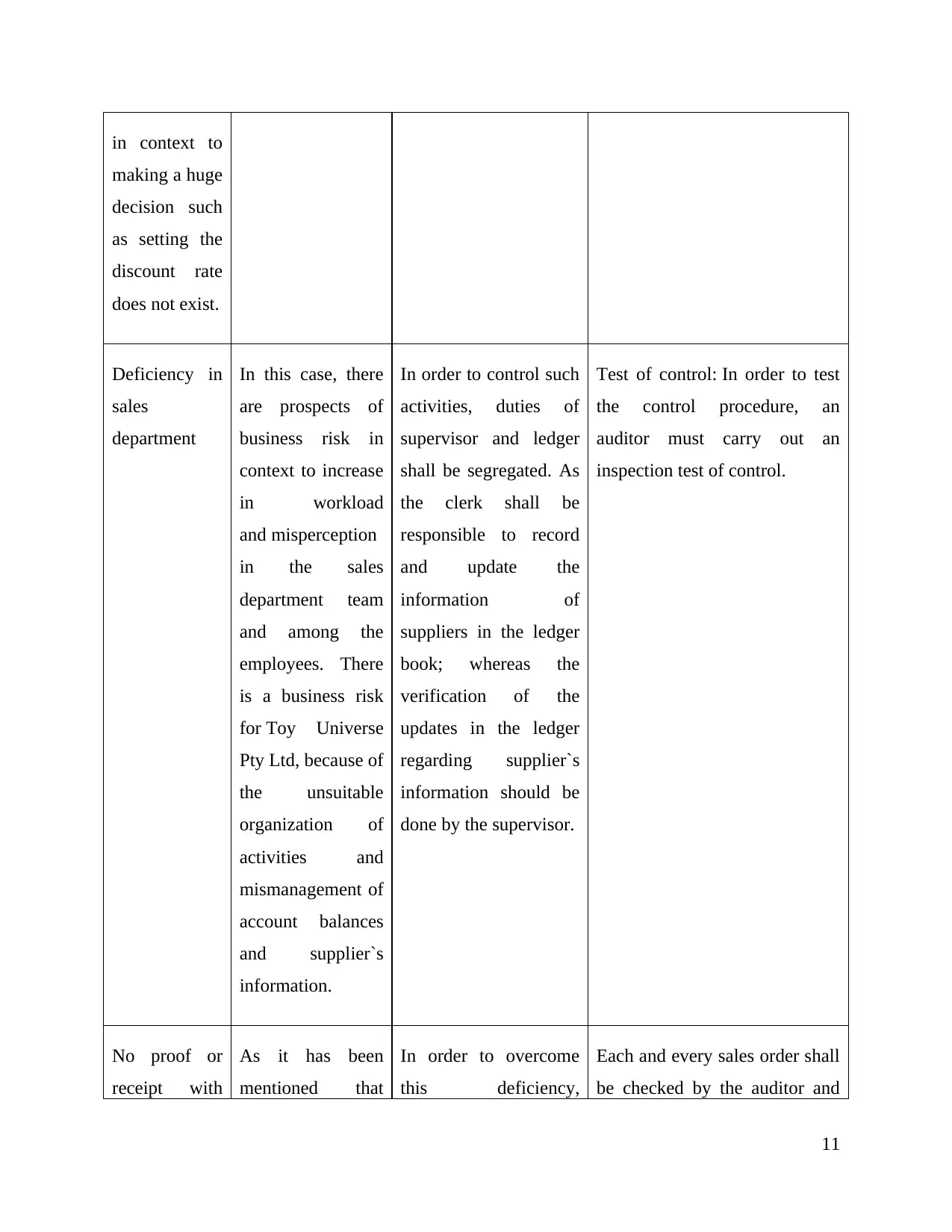
in context to
making a huge
decision such
as setting the
discount rate
does not exist.
Deficiency in
sales
department
In this case, there
are prospects of
business risk in
context to increase
in workload
and misperception
in the sales
department team
and among the
employees. There
is a business risk
for Toy Universe
Pty Ltd, because of
the unsuitable
organization of
activities and
mismanagement of
account balances
and supplier`s
information.
In order to control such
activities, duties of
supervisor and ledger
shall be segregated. As
the clerk shall be
responsible to record
and update the
information of
suppliers in the ledger
book; whereas the
verification of the
updates in the ledger
regarding supplier`s
information should be
done by the supervisor.
Test of control: In order to test
the control procedure, an
auditor must carry out an
inspection test of control.
No proof or
receipt with
As it has been
mentioned that
In order to overcome
this deficiency,
Each and every sales order shall
be checked by the auditor and
11
making a huge
decision such
as setting the
discount rate
does not exist.
Deficiency in
sales
department
In this case, there
are prospects of
business risk in
context to increase
in workload
and misperception
in the sales
department team
and among the
employees. There
is a business risk
for Toy Universe
Pty Ltd, because of
the unsuitable
organization of
activities and
mismanagement of
account balances
and supplier`s
information.
In order to control such
activities, duties of
supervisor and ledger
shall be segregated. As
the clerk shall be
responsible to record
and update the
information of
suppliers in the ledger
book; whereas the
verification of the
updates in the ledger
regarding supplier`s
information should be
done by the supervisor.
Test of control: In order to test
the control procedure, an
auditor must carry out an
inspection test of control.
No proof or
receipt with
As it has been
mentioned that
In order to overcome
this deficiency,
Each and every sales order shall
be checked by the auditor and
11
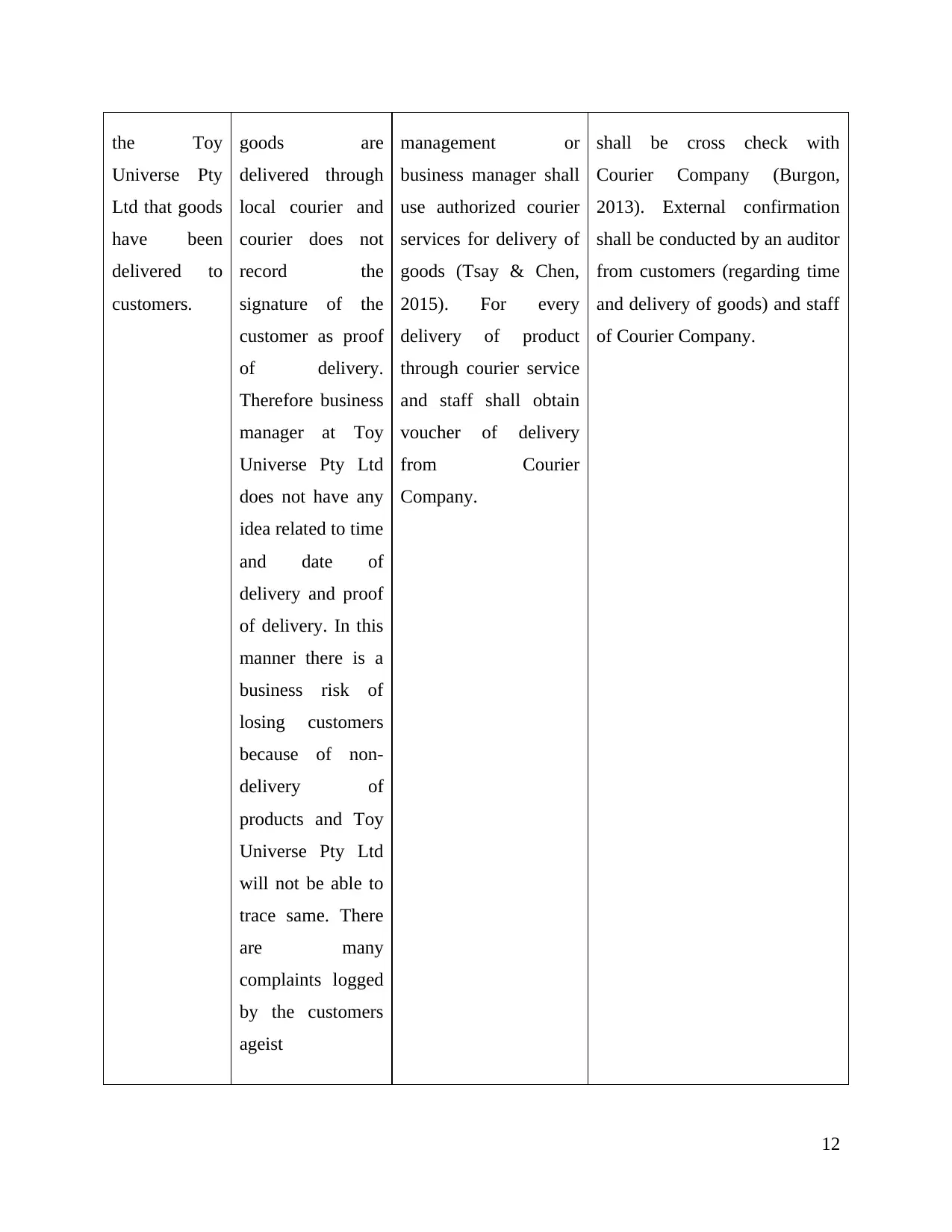
the Toy
Universe Pty
Ltd that goods
have been
delivered to
customers.
goods are
delivered through
local courier and
courier does not
record the
signature of the
customer as proof
of delivery.
Therefore business
manager at Toy
Universe Pty Ltd
does not have any
idea related to time
and date of
delivery and proof
of delivery. In this
manner there is a
business risk of
losing customers
because of non-
delivery of
products and Toy
Universe Pty Ltd
will not be able to
trace same. There
are many
complaints logged
by the customers
ageist
management or
business manager shall
use authorized courier
services for delivery of
goods (Tsay & Chen,
2015). For every
delivery of product
through courier service
and staff shall obtain
voucher of delivery
from Courier
Company.
shall be cross check with
Courier Company (Burgon,
2013). External confirmation
shall be conducted by an auditor
from customers (regarding time
and delivery of goods) and staff
of Courier Company.
12
Universe Pty
Ltd that goods
have been
delivered to
customers.
goods are
delivered through
local courier and
courier does not
record the
signature of the
customer as proof
of delivery.
Therefore business
manager at Toy
Universe Pty Ltd
does not have any
idea related to time
and date of
delivery and proof
of delivery. In this
manner there is a
business risk of
losing customers
because of non-
delivery of
products and Toy
Universe Pty Ltd
will not be able to
trace same. There
are many
complaints logged
by the customers
ageist
management or
business manager shall
use authorized courier
services for delivery of
goods (Tsay & Chen,
2015). For every
delivery of product
through courier service
and staff shall obtain
voucher of delivery
from Courier
Company.
shall be cross check with
Courier Company (Burgon,
2013). External confirmation
shall be conducted by an auditor
from customers (regarding time
and delivery of goods) and staff
of Courier Company.
12
⊘ This is a preview!⊘
Do you want full access?
Subscribe today to unlock all pages.

Trusted by 1+ million students worldwide
1 out of 15
Related Documents
Your All-in-One AI-Powered Toolkit for Academic Success.
+13062052269
info@desklib.com
Available 24*7 on WhatsApp / Email
![[object Object]](/_next/static/media/star-bottom.7253800d.svg)
Unlock your academic potential
Copyright © 2020–2025 A2Z Services. All Rights Reserved. Developed and managed by ZUCOL.




